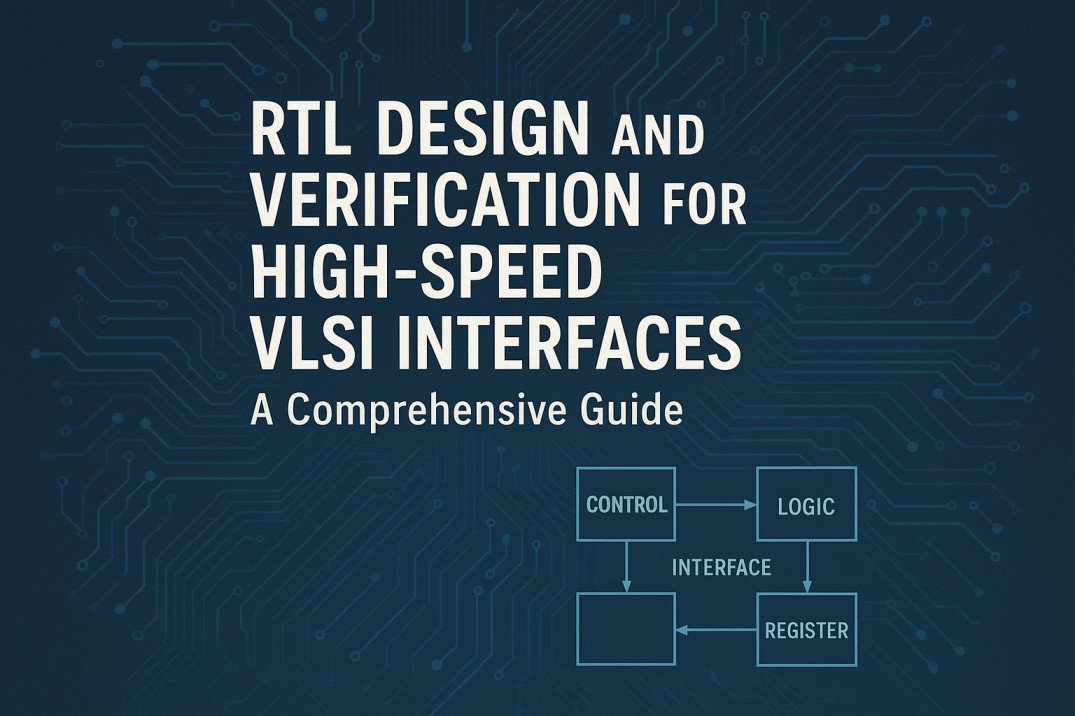RTL Design and Verification for High-Speed VLSI Interfaces: A Comprehensive Guide
In the fast-evolving world of Very Large Scale Integration (VLSI), high-speed interfaces are the backbone of modern electronic systems. From smartphones to data centers, these interfaces enable seamless data transfer at lightning-fast speeds. At the heart of this technology lies Register-Transfer Level (RTL) design and verification—a critical process that ensures high-speed VLSI interfaces perform reliably and efficiently. In this article, we’ll dive into the intricacies of RTL design and verification, explore their importance in high-speed VLSI interfaces, and share practical insights for engineers and enthusiasts alike.
Understanding RTL Design in VLSI
RTL design is a pivotal step in the VLSI design flow, where the behavior of a digital circuit is described at the register-transfer level. This abstraction level focuses on how data moves between registers and the logical operations performed on it. For high-speed VLSI interfaces like USB, PCIe, DDR, or HDMI, RTL design translates high-level system requirements into synthesizable hardware descriptions using languages like Verilog or VHDL.
Why is RTL design crucial for high-speed interfaces? These interfaces operate at gigabit-per-second speeds, demanding precise timing, low power consumption, and robust error handling. A well-crafted RTL design ensures the circuit meets these stringent requirements while remaining scalable and adaptable to future upgrades.
Key Considerations in RTL Design
- Timing Constraints: High-speed interfaces require meticulous timing analysis to ensure signals propagate correctly within clock cycles. Designers must account for setup and hold times, clock skew, and jitter.
- Power Optimization: With power efficiency being a priority, RTL designers use techniques like clock gating and power-aware state machines to minimize energy consumption.
- Modularity: A modular RTL design simplifies debugging, reuse, and integration into larger systems, especially for complex interfaces like PCIe or DDR5.
- Compliance with Standards: High-speed interfaces adhere to strict industry standards (e.g., USB-IF, JEDEC). RTL designs must incorporate protocol-specific features like error correction and handshake mechanisms.
The Role of Verification in High-Speed VLSI Interfaces
Verification is the process of ensuring that the RTL design functions as intended under all possible conditions. For high-speed VLSI interfaces, verification is particularly challenging due to the complexity of protocols, high data rates, and the need for interoperability. A single flaw in the design can lead to data corruption, system crashes, or failure to meet compliance standards.
Why Verification Matters
High-speed interfaces handle massive data volumes in real-time applications, such as 5G networks, autonomous vehicles, and AI accelerators. Verification ensures the design is robust, reliable, and compliant with specifications. Without thorough verification, even a minor bug can cascade into costly redesigns or product failures.
Verification Techniques for High-Speed Interfaces
- Simulation-Based Verification:
- Functional Simulation: Using tools like ModelSim or VCS, engineers simulate the RTL design to verify its behavior against testbenches. Testbenches mimic real-world scenarios, including edge cases like packet loss or signal noise.
- Coverage Analysis: Code coverage (e.g., line, branch, toggle) and functional coverage ensure all parts of the design are exercised. For high-speed interfaces, achieving 100% coverage is critical to catch corner-case bugs.
- Formal Verification:
- Formal methods use mathematical techniques to prove the correctness of the RTL design. Tools like Cadence JasperGold or Synopsys VC Formal verify properties like deadlock-free operation or protocol compliance.
- For high-speed interfaces, formal verification is invaluable for ensuring adherence to complex protocols like PCIe’s transaction layer.
- Emulation and FPGA Prototyping:
- Emulation platforms like Palladium or Veloce allow engineers to test the RTL design in a near-real hardware environment. FPGA prototyping, using boards like Xilinx Zynq, validates the design at speed, catching issues that simulations might miss.
- Universal Verification Methodology (UVM):
- UVM is a standardized framework for creating reusable, scalable testbenches. It’s widely used for high-speed interfaces due to its ability to handle complex test scenarios and randomized stimuli.
Challenges in RTL Design and Verification
Designing and verifying high-speed VLSI interfaces is no walk in the park. Here are some common hurdles and how engineers tackle them:
1. Timing Closure
High-speed interfaces operate at multi-GHz frequencies, making timing closure a significant challenge. Designers use static timing analysis (STA) tools like Synopsys PrimeTime to ensure the design meets timing requirements. Techniques like pipelining and retiming help optimize critical paths.
2. Signal Integrity
At high speeds, issues like crosstalk, electromagnetic interference (EMI), and signal attenuation can degrade performance. RTL designers collaborate with physical design teams to ensure proper signal routing and impedance matching.
3. Protocol Complexity
Interfaces like USB4 or DDR5 involve intricate protocols with multiple layers (e.g., physical, data link, transaction). Verification engineers create comprehensive test plans to cover all protocol states, including error handling and recovery mechanisms.
4. Power and Area Constraints
High-speed interfaces must balance performance with power and area efficiency. Designers use low-power techniques like dynamic voltage scaling, while verification ensures these optimizations don’t compromise functionality.
Best Practices for RTL Design and Verification
To create robust high-speed VLSI interfaces, engineers follow these best practices:
- Start with a Clear Specification:
- A detailed specification, aligned with industry standards, serves as the foundation for both design and verification. For example, a PCIe interface design must comply with the PCI-SIG specification.
- Adopt a Hierarchical Design Approach:
- Break the design into smaller, manageable modules (e.g., transmitter, receiver, controller). This simplifies verification and improves reusability.
- Leverage Automation:
- Use automation tools for testbench generation, coverage analysis, and regression testing. Tools like Synopsys Verdi or Cadence vManager streamline the verification process.
- Incorporate Real-World Scenarios:
- Testbenches should include real-world conditions like noise, jitter, and packet errors. Randomized testing helps uncover hidden bugs.
- Collaborate Across Teams:
- RTL designers, verification engineers, and physical design teams must work closely to address issues like signal integrity and timing closure early in the process.
Tools and Technologies
The VLSI industry relies on a robust ecosystem of tools for RTL design and verification. Some popular ones include:
- Design Tools: Synopsys Design Compiler, Cadence Genus, Xilinx Vivado
- Simulation Tools: Mentor Questa, Synopsys VCS, Cadence Incisive
- Formal Verification: Synopsys VC Formal, Cadence JasperGold
- Emulation Platforms: Mentor Veloce, Cadence Palladium, Synopsys ZeBu
- STA Tools: Synopsys PrimeTime, Cadence Tempus
Open-source tools like Verilator and Yosys are also gaining traction for cost-effective RTL design and verification.
The Future of RTL Design and Verification
As high-speed interfaces evolve, so do the demands on RTL design and verification. Emerging trends include:
- AI-Driven Design: Machine learning is being used to optimize RTL code and automate testbench creation.
- Chiplet-Based Architectures: High-speed interfaces like UCIe (Universal Chiplet Interconnect Express) are driving modular, chiplet-based designs, requiring new verification strategies.
- Higher Speeds and Bandwidth: Interfaces like PCIe 6.0 and DDR6 are pushing the boundaries of speed, demanding advanced timing and power optimization techniques.
- Security Verification: With rising cybersecurity threats, verification now includes checks for vulnerabilities like side-channel attacks.
Conclusion
RTL design and verification are the cornerstones of building reliable, high-performance VLSI interfaces. By combining meticulous design practices with rigorous verification, engineers ensure that interfaces like USB, PCIe, and DDR meet the demands of modern applications. As technology advances, staying ahead requires embracing new tools, methodologies, and collaborative approaches. Whether you’re a seasoned VLSI engineer or a curious newcomer, understanding the art and science of RTL design and verification opens the door to creating the next generation of high-speed interfaces.
Ready to dive deeper into VLSI design? Share your thoughts or questions in the comments below, and let’s keep the conversation going!



